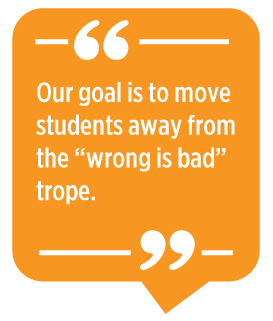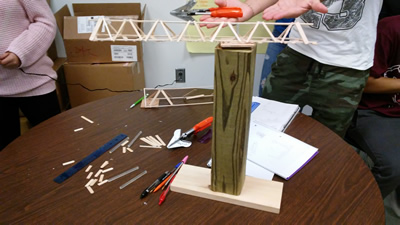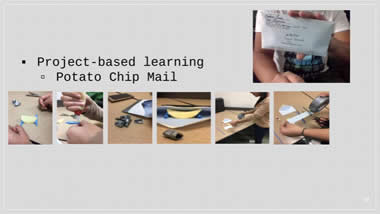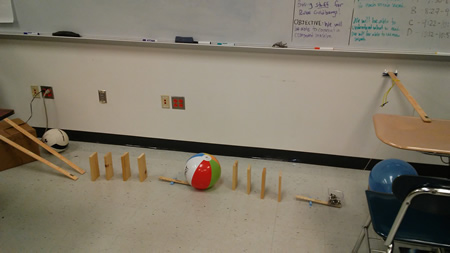Try, Fail, Succeed, Repeat: Taking Risks in STEM
by Katie Miller and Holly Sawyer
 All educators can agree that fear of failing is an
obstacle to learning. Nobody fears success. We’re afraid to try because we’re
afraid to fail. Our multilingual students must overcome their affective filters
to communicate in English. There are many kinds of fear our learners may face:
Newcomers can be so overwhelmed in a new culture and school environment that
they become “deer in the headlights.” Kids can be mean, so why would anyone
volunteer an answer only to be met with ridicule if wrong? Some students have
unrealistic expectations for their learning, like the student who says they’ll
learn English in one year, or the one who’s demoralized by one incorrect
answer.
All educators can agree that fear of failing is an
obstacle to learning. Nobody fears success. We’re afraid to try because we’re
afraid to fail. Our multilingual students must overcome their affective filters
to communicate in English. There are many kinds of fear our learners may face:
Newcomers can be so overwhelmed in a new culture and school environment that
they become “deer in the headlights.” Kids can be mean, so why would anyone
volunteer an answer only to be met with ridicule if wrong? Some students have
unrealistic expectations for their learning, like the student who says they’ll
learn English in one year, or the one who’s demoralized by one incorrect
answer.
Our goal is to move students away from the “wrong is
bad” trope. In our high school STEM and English Language Development classes,
we incorporate many opportunities for students to fail on purpose in order to
increase their confidence and allow them to ultimately succeed.
Why STEM?
English learners (ELs) are significantly
underrepresented in STEM classes and careers (National Academy of Sciences et
al., 2011; National Academies of Sciences et al., 2018). Despite the challenge
of learning academic English alongside diverse content-specific knowledge,
secondary ELs experience better outcomes with opportunities to learn academic
content (Tolbert, 2018).
Math, engineering, and coding classes provide
unique opportunities for ELs to engage in problem-based learning, where
solutions often fail on an attempt. A regular engagement with failure and
success cultivates a mindset, computational thinking, where problem-solving
moves from an act to a practice. It works like this: When a human interacts
with a computer, extreme precision is required and if an error ensues, it’s
likely from the human side. The human is responsible for communicating
effectively. If one direction in the algorithm is off, then the entire program
won’t work. This generates many problems, which become expected. Their
frequency brings a tolerance and acceptance of making errors. This valuable
skill benefits our students as they engage with a new language and,
undoubtedly, make errors. The risk of making errors can bring fear, but with a
computer, the stakes are low or nonexistent: Computers won’t pass judgement.
 Testing an algorithm for errors is a necessity. We
want students to expect to try, fail, succeed, and repeat.
This also requires a mindset shift. Normally in education, an end product is
completed and then evaluated; this is known as waterfall methodology. In
contrast, agile methodology has students regularly test their program as it is
being coded. (Read about both waterfall and agile methodologies in the free
issue of Hello World magazine, “The
Big Book of Computing Content.”) Testing in agile methodology is like
the approach’s namesake: flexible, incremental, and iterative. Microerrors are
caught and corrected frequently. This ongoing testing normalizes failure: “Here
we go again, teacher.” Students begin to expect to struggle, likely fail in a
communication attempt, work through problems, and repeat the process all over
again. We see persistence and resilience develop—all important in learning a
new language.
Testing an algorithm for errors is a necessity. We
want students to expect to try, fail, succeed, and repeat.
This also requires a mindset shift. Normally in education, an end product is
completed and then evaluated; this is known as waterfall methodology. In
contrast, agile methodology has students regularly test their program as it is
being coded. (Read about both waterfall and agile methodologies in the free
issue of Hello World magazine, “The
Big Book of Computing Content.”) Testing in agile methodology is like
the approach’s namesake: flexible, incremental, and iterative. Microerrors are
caught and corrected frequently. This ongoing testing normalizes failure: “Here
we go again, teacher.” Students begin to expect to struggle, likely fail in a
communication attempt, work through problems, and repeat the process all over
again. We see persistence and resilience develop—all important in learning a
new language.
Combating Math Phobia
Many people, of any age, often have a visceral
reaction to math. Fear comes from not knowing how to approach a problem and in
having to decide what possible tools you can use to solve it. We start with
teaching formulas and processes with defined steps, such as how to simplify an
equation. To help mitigate this fear, here are some strategies you can
encourage students to try:
-
Answer Bank: If they
don’t arrive at one of the answers on their first attempt, they try again.
Students perceive the task as matching to something already there, providing a
small sense of security.
-
Mini-Whiteboards:
Students who are paralyzed with fear and don’t know what to do can start by
copying the problem and discreetly flashing their first step attempt at the
teacher during guided practice. Constant feedback encourages them to make corrections
to their formula. Students can show each other their models where different,
and creative solutions are anticipated.
-
Start From the Solution: Take fear of the unknown out of the equation: “Spoiler alert! X
equals 3!” Have students work through the process and show the steps to arrive
at that correct answer. They will still demonstrate understanding of the skill,
but the fear of not arriving at the correct destination is gone.
-
Calculator: Many of
our high school newcomers have had limited or interrupted formal education and
lack math fact fluency. However, we don’t want the fear of miscalculating 6 x 7 to stop them from attempting a solution in algebra
class. Using a calculator frees up mental energy to apply formulas correctly or
demonstrate they know which numbers to calculate (and how and why).
Engineering Design: Process vs. Product
We teach the engineering design process as an
iterative process always focused on improvement: Define the problem, brainstorm
ideas, explore solutions, generate a model, and test and evaluate.
Whether using LEGO blocks or computer-aided design
programs to model designs, it’s often easier for students to completely take
apart, erase, or start over if something goes wrong. They’re not starting from
scratch, but from experience. When we build wooden structures like towers or
cranes that are designed to hold weight, we will test until they literally
break apart (see Figure 1). We don’t know how much weight they can bear, or
know the limit of the designs until we push past those limits. Students take
pride in constructing their design, but, ultimately, their beautiful structure
will be smashed to bits.

Figure 1. Building structures to test
limits.
It’s important to separate the design from the
student: The former fails, but the latter grows. A student can get an A for a
project even if the design fails. By completing an engineering design journal
for each project, we can see how the students thought through every aspect of
their design, including criteria, constraints, materials, and math
calculations.
⮚ Fun Classroom Challenge:
Use plastic straws, tape, and cardboard to modify an envelope to carry a single
potato chip in the mail. The chips hardly ever come back intact after a journey
through interoffice mail (see Figure 2).

Figure 2. Project-based learning potato chip
mailer.
(Click here to enlarge)
We also build Rube
Goldberg machines (see Figure 3). Students must stop and restart
their machine dozens of times before it works successfully. Though students do
get frustrated when their machine doesn’t work as planned, more often than not,
they laugh. By normalizing the expectation of failure, you help them understand
that they will have to continuously tweak their design and try again.

Figure 3. Rube Goldberg project.
Strategies to Fail Forward
1. Model Expectation of
Failure
Even teachers fail! But we can demonstrate how to
keep our cool and bounce back.
2. Unplugged First, Then Plugged
Lesson Sequence
Students first work with the concept in a
real-world, unplugged context. They then transfer the concept to their coding
task. This embeds additional opportunities to try, fail—and succeed! It also animates
them with a fun, highly engaging real-world activity before they sit down and
extend the concept in technology.
⮚ Fun Classroom
Challenge: Write directions between two locations in the school for
a classmate to follow. (E.g., “Move one step forward. Turn left. Move five
steps forward.”) Upon arrival, the classmates take a selfie in the location.
Did they arrive where they were supposed to? Then, plug in and program a robot
to move to a destination.
⮚ Fun Classroom
Challenge: To prepare students to code conditional statements,
create and play a red light–green light game using an “If ___, then___;
otherwise ___” sentence frame. Look out! Students have substantial fun
sabotaging their friends with very personal statements based on what they know
about each other. (E.g., “If you have a bird as a pet, then walk two steps
forward.”) They write, then listen, react, and laugh. When it is later time to
code conditional statements, they draw from this familiar language experience.
3. Teach the Language of
Problem-Solving
Language and content go hand in hand: Knowing the
language of the STEM area helps students understand the process, complete the
steps of the algorithm, and organize thoughts for reflection. Begin by teaching
the language to ask for help; provide sentence stems for asking for assistance
from the teacher and peers, and for how to offer assistance to a confused
classmate, because these can be used at any time. Following is some common
language used in STEM that will help students solve their problems:
- Coding: conditionals with
if/then, dependent clause, imperatives
- Engineering: text structures
such as cause/effect, problem/solution, compare/contrast
- Math: multiple meaning
words, such as step (on the stairs) and step (one operation in a process)
4.
Collaboration
Students benefit from interactive peer support, or
peer programming. This enables them to get/give more immediate feedback from
peers (not just the teacher). We always have students work in pairs or small
groups. It’s helpful when one student can give an oral direction and the other
can enter the program or manipulate the design.
5. Manage Socioemotional
Expectations
Emphasize progress and growth, not perfection.
-
As students leave their comfort zones, teach them
words to identify and express emotions, with attention to gradiency: “Are you
annoyed, mad, or furious?”
-
Take frequent pulse or vibes checks; for example,
have students hold up fingers on a scale of 1 to 5 to answer “How are you right
now?”
-
Use humor to put anxious students at ease: “I
will call 911 if you are injured by solving this equation.”
Try, fail, succeed, repeat: Teachers of ELs have a
real opportunity to engage in this very process themselves. Try! Try to
incorporate STEM content and be determined to learn alongside your students.
Fail. But be agile and flexibly adjust your teaching practice. Succeed!
Celebrate the learning of language and STEM, integrated. And, repeat.
References
Bell, P. (2022). Testing the Fear Love of Failure. In The Big Book
of Computing Content (2nd ed.; pp. 136–137). Raspberry Pi Foundation.
National Academy of Sciences, National Academy of
Engineering, & Institute of Medicine. (2011). Expanding
underrepresented minority participation: America's science and technology
talent at the crossroads. The National Academies Press. https://doi.org/10.17226/12984
National Academies of Sciences, Engineering, and
Medicine. (2018). English learners in STEM subjects: Transforming
classrooms, schools, and lives. The National Academies Press. https://doi.org/10.17226/25182
Tolbert, S. (2018). EL STEM committee
report: Secondary science education for English learners. The
National Academies Press.
Katie
Miller is a National Board Certified Teacher
who has taught ESOL and STEM in secondary and adult education programs. She was
most recently a high school EL Department chair and is now an EL Fellow with
the U.S. Department of State in Kyrgyzstan. Katie holds a BSLA in French from
Georgetown University and an MA in applied linguistics and TESOL from Old
Dominion University. She is a past president of Maryland TESOL
(2020–2021).
Holly
Sawyer is a National Board Certified
Teacher who currently teaches English Language Development in secondary school in
Chesapeake, Virginia, USA and has also specialized in early childhood ESL.
During pandemic teaching, she discovered coding as a vehicle for language
learning, integrates it in her instruction, and documents her students’ success
on her blog. Holly is a Spanish learner with a BA in foreign languages and a MA
in applied linguistics from Old Dominion University.